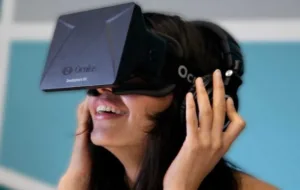Wired magazine has released an interview with Oculus CEO Brendan Iribe, in which he states that Oculus will focus in the immediate future on Virtual Reality (VR) rather than Augmented Reality (AR). This distinction is often lost or even used incorrectly by many consumers.
So far AR solutions like Google Glass where seen as consumer-oriented devices that promised the average user information retrieval and communication capabilities typically found only in SciFi movies. They are defined by a see-through optical path that allows the user to mix real world images with computer generated graphical content.
Source: Forbes
On the other hand, VR puts a display in front of the user’s eyes that cuts him completely off from the outside world. Some companies have incorporated cameras that allow the user to see a representation of the outside world in combination with the VR content. For many this seemed to be a typical approach for gamers, and in fact this was the first application Oculus mentioned.
While both approaches are very similar in providing content to a viewer via a head mounted display, there is a distinct difference in the potential applications based on the two device types.
In the interview, Iribe describes VR as the market with lower overall potential, but also lower technological barriers. According to him, the difficulties in AR are reaching from limited field of view, dealing with uncontrolled head movements, vergence – accommodation conflicts and unfashionable hardware. Of course, there is also the issue of social awkwardness that Google ran into.
In the interview Iribe suggests that it may be years or even decades before AR may reach a state where technology can actually produce usable glasses.
Analyst Comment
While the Oculus arguments are not new and pretty much on point, VR by itself is no easy task as well. So far, field of view maybe a bigger issue for VR, as the display technology creates a smaller field of vision than people are used to in real life. In most cases the peripheral vision is clipped creating a weird feeling in the user. In addition the system needs to create a 3D presentation of the surroundings and include the VR content to create a realistic environment.
When it comes to fashionable devices and social awkwardness, I think nothing will beat a VR headset that completely disconnects the user from the real world. From that perspective, a VR headset may be the most unfashionable item I own, but since I am most likely alone while using it, nobody cares.
What the interview does not touch on is the difference in the markets the products address. So far AR seems to focus on professional applications, while VR is focused on entertainment (games and environments). One is typically measured by return on investment (in terms of money or productivity), while the other is measured by entertainment value.
Overall, both approaches will be entering the market as soon as they can produce a good experience at a reasonable price. When that will be is still open for debate. As it seems, Oculus is ready for a 2016 launch, coincidentally this was also what Google was saying before it pulled the plug. While I do not believe that Oculus will actually stop short of a consumer release, the key question is the ultimate success in the market place. – NH

